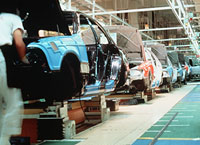|
|
|||||||
|
|
|||||||
|
|||||||
| | Web Japan >> | Trends in Japan >> | Business & Economy >> | Turning Point | |
|
TURNING POINT Upturn in Capital Investment by Manufacturers (August 7, 2003) Despite a sustained bout of deflation in the wider economy, companies in key sectors of the manufacturing industry, such as electrical appliances, automobiles, and steel, have begun increasing their investment in plant and equipment. Corporations that have nearly concluded radical restructuring efforts, such as by shrinking factory operations, closing down factories, and laying off workers, are now ready to go on the offensive, working to improve productivity and profitability in growth sectors. Playing a leading role is "survival investment," which involves focusing on growth businesses, enhancing performance to boost efficiency, and developing new markets. Because investment by one company has a positive knock-on effect on many others, there are hopes that the recent surge in manufacturing investment will lead to an economic recovery.
Survival Investment The biggest locomotive of industry investment as a whole is the electrical-appliance sector, and the nine major companies in this industry raised investment for the first time in three years after giving themselves some money to work with by cutting costs. Sony Corp., which has cut investment by more than 20% in each of the past two years, will boost investment by 18% this year based on the realization that semiconductors and Internet technology are set to take off and that this is an excellent time to take advantage of the opportunities they offer. Sony plans to up its investment in the semiconductors used in video-game consoles, a major source of profits, by 130% to ¥175 billion ($1.46 billion). Toshiba Corp. has also decided to go on the offensive, bolstering investment by a whopping 44%. More than half of the funds it will use - ¥151 billion ($1.26 billion) - will be invested in electronic parts, such as flash memory and system LSI semiconductors. Sharp Corp. plans to raise its investment to its highest level ever, concentrating 60% of this money - ¥108 billion ($900 million) - on its liquid-crystal display business. In order to win the battle with South Korea's Samsung Electronics for the lead in manufacturing LCD TV sets, Sharp is working to make bigger screens. Sharp plans to use new equipment and methods to make production of big-screen (40-inch-plus) LCD TVs more efficient at its integrated-production plant in Kameyama, Mie Prefecture.
New Opportunities to Invest The four major steel companies have increased investment for the first time in two years. Sumitomo Metal Industries is investing ¥47 billion ($392 million) to build a new blast furnace at its plant in Kashima, Ibaraki Prefecture. After the new furnace goes on line next fall, the plant will be able to produce more than 1 million tons of crude steel annually. And with the increased production capacity that will result from the intensification of its steel-plate production facilities at the end of fiscal 2004, the firm hopes to greatly improve its competitiveness. Nippon Steel Corp. and JFE Steel Corp. intend to use their investment to upgrade existing facilities. The business environment in Japan has been tough recently, and investment had fallen over the past few years as companies worked to become leaner. That investment is now increasing is seen as a sign that these firms have turned the corner and are ready to take the initiative again. For example, major Japanese makers of semiconductors have already paid off 70% of their plant and equipment, compared with a reported rate of around 50% for foreign firms. This should provide domestic producers with an edge in profitability. The view is growing within industry that the coming two to three years offer good opportunities to invest. Related video Sony Corp. Toshiba Corp. Sharp Corp. Toyota Motor Corp. Mitsubishi Motors Corp. Mazda Motor Corp. Sumitomo Metal Industries Nippon Steel Corp. JFE Steel Corp. Copyright (c) 2004 Web Japan. Edited by Japan Echo Inc. based on domestic Japanese news sources. Articles presented here are offered for reference purposes and do not necessarily represent the policy or views of the Japanese Government. |
IS SPRING ABOUT TO ARRIVE FOR THE ECONOMY? (May 23, 2002) TAKING CARE OF BUSINESS (January 31, 2002) |
|
|



